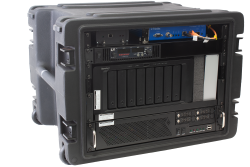DASA-2507 - Digital Acoustic Surveillance Arrays

DASA-2507 is a low-frequency acoustic sea-bed array platform designed for long-term area monitoring and surveillance applications. This DASA variant has 94 low-frequency hydrophones installed to form 6 linear apertures (10, 20, 40, 80, 160, 320 Hz) spanning the 1600 m array length. Apertures are centered on the array and contain 24-28 hydrophones at each center frequency.
The array construction and digital sampling format have been designed to support a wide range of array lengths, and sensor positions, and sampling rates. DASA is a proven system with multiple deployed configurations ranging from 100 m to 1600 m long using as many as 94 hydrophones in multiple nested apertures.
DASA-2507 was designed for long-term deployments with a shore-connected cable to remote locations with limited available power.
The system can also be modified as a battery-powered autonomous recording system or built in smaller versions such as DARU-2515
The lower power electronics allow for longer, smaller, shore cables and reduce the power requirements at remote operating sites.
Each DASA configuration can be customer-defined or can be selected to match from a list of predefined systems. Customers can select array length, sampling rate, and sensor count with a near-linear trade-off between these parameters.
Highlights
- Hydrophones: 94
- Length: 1600 m
- Max. Depth: 2000 m
- Apertures: 6, linear, nested
- Segments: 5
- Spooling Radius: 1 m
- Power: Shore Cable
- Deployment Duration: > 5 years
- Aux. Sensors Connections: 6
- Coms: Acoustic Modem, Ethernet
Area Surveillance and Tracking
DASA can be used for large area monitoring and target tracking by deploying two orthogonal arrays in the area of interest. Bearings from each array provide cross fixes that build target tracks for surveillance and area awareness.
Hydrophones
The Low-Frequency hydrophones for DASA are a low-noise, low-power design. The hydrophones attach to molded connectors on the array cable and are held in place by a protective plastic shroud. The hydrophone pressure vessel is constructed from Grade 2 Titanium and is designed for long-duration, deep water deployments. The hydrophone electronics are gain matched and simultaneously sampled. Sensor specifications are provided in the datasheet.
Side Channel Data
In addition to the acoustic samples, sensors within hydrophones and DCU measure and record diagnostic and auxiliary information including voltage, power usage, battery level (when applicable), hydrophone orientation, internal case temperature, pressure, and humidity.
Array Receiver
The DASA connects to an included Array Receiver/Controller (ARC) that manages the array power, receives sensor samples from array data buses, and computes diagnostic and health monitoring records. If enabled, the ARC will also run data processing algorithms, record data to solid-state storage, and/or send data to a remote, connected interface on a surface buoy or shore.
Segment Linkages
DASA cable segments are connected through custom low-profile linkages design to be spooled with the array cables during deployment and recovery. The linkages contain inline data repeaters and mechanical couplings that are rated to pass the full breaking strength of the array cable.

Additional Sensors
The DASA sensor bus format supports many different sensor types that can be included with the acoustic array. The system can add one or more high-frequency hydrophones (up to 192 kSps). Three-axis magnetometers can be installed in place of acoustic array channels. The acoustic channels can be configured over one or more arrays in any geometry. Systems have been configured with horizontal, vertical, circular, and orthogonal 3-axis arrays.
Data Processing
The DASA Array Receiver Controller (ARC) runs a custom Linux operating system on a dual-core ARM Cortex-A9 processor with an FPGA coprocessor. The ARC software includes functions for array operation, logging, scheduling, health monitoring, and energy/event detectors. Omnitech Electronics provides user support and comprehensive interface definitions and data API’s that users can use to integrate additional functionality and data processing. Users can use spare processing on the ARC or add a separate coprocessor.
